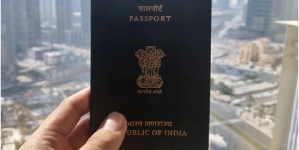-
LONDON: Indian-Origin Teen In UK Gets “Life-Changing” Cancer Treatment - 1 day ago
-
SILICON VALLEY: All About Pavan Davuluri, New Head Of Microsoft Windows - 1 day ago
-
LONDON: UK’s India Gate To Commemorate Role Of Indian Soldiers From World Wars - April 24, 2024
-
HARARE: Shri Bramha Kumar appointed as the next Ambassador of India to the Republic of Zimbabwe - April 23, 2024
-
LONDON: Indian-Origin Principal Wins UK Legal Challenge Over School Prayer Ban - April 23, 2024
-
TORONTO: Indian-Origin Doctor Needs ₹ 2 Crore For Legal Fees. Elon Musk Responds - April 22, 2024
-
KINSHASA: India-Democratic Republic of Congo Foreign Office Consultations - April 21, 2024
-
LONDON: UK Court Allows Sale Of Nirav Modi’s Luxury London Apartment - April 21, 2024
-
TEHRAN: Travel advisory for Iran and Israel - April 20, 2024
-
LUXEMBOURG: Shri Saurabh Kumar concurrently accredited as the next Ambassador of India to the Grand Duchy of Luxembourg - April 20, 2024
TORONTO: With 27,660 admitted as permanent residents in Canada, Indians led the pack in 2020
TORONTO: After a little over a hundred years, Canada hit an historic high by welcoming more than 4.01 lakh new permanent residents during 2021, thus meeting its immigration levels target. The targets for the coming years are 4.11 lakh in 2022 and 4.21 lakh in 2023.
However, owing to the pandemic, the ‘Express Entry’ draws, which is the popular point-based permanent residence program in Canada for skilled workers focused on the Canadian Experience Class (CEC) and Provincial Nominee Program (PNP) categories. As these covered individuals already in Canada on temporary visas they were not impacted by the Covid-19 fuelled travel restrictions.
A country wise break up of the figures of 2021 are not available, but going by past trends Indians are likely to constitute around 40% of this historic total.
The Immigration, Refugees and Citizenship Canada (IRCC) – the immigration unit of the Canadian government, has recently released the ‘Express Entry Report-2020’, which provides country-wise data.
In 2020, Indian citizens bagged 50,841 invites to apply for permanent residence in Canada, under the ‘Express Entry’ route. This is 47% of the total invites (1.07 lakh) which were issued by IRCC. The ratio has remained unchanged from the previous year, when Indian citizens got 40,314 invites.
For the past several years, India has led the charts both in terms of the number of invites issued to its citizens for permanent residency.
Candidates that receive an invitation to apply have 90 days to either decline the invitation or submit an online application for permanent residence to IRCC. After a due process, applicants and their accompanying family members become permanent residents when they are admitted to Canada.
The year 2020 saw a drop in those admitted into Canada as permanent residents. Only 63,923 principal applicants and their accompanying family members were admitted during this year, as compared to 1.09 lakh in the previous year. This year saw 27,660 Indian applicants and their family members being admitted as permanent residents, as compared to 50,848 in 2019. Even on the parameter of admission, Indians led – and comprised 43% of the total admissions into Canada. Permanent residence is akin to the green card in the US – it is often the first step towards transition to citizenship.
Prior to the pandemic, a significant number of new permanent residents came from their own home country – rather than a transition of temporary visa holders to permanent residents. With the focus on CEC and PNP class for Express Entry draws, 63% of the invites for permanent residence were issued to those already in Canada. Correspondingly, the number of invited candidates who were present in India, dropped to 10% from 18% in 2019.
Talha Mohani, legal counsel, at Migration Bureau Canada, an immigration services firm points out, “Considering that the highest numbers of temporary resident status such as study permits are granted to Indian nationals, they are the ones expected to benefit the most from the temporary public policies focusing on the grant of permanent resident status to those present in Canada.”
Josh Schachnow an immigration lawyer and founder of Visto.ai, a platform that helps Canadian companies find global tech talent, told TOI, “A few months ago I was starting to think that maybe they would go back to all-program draws, but as Omicron becomes more serious and shutdowns are looming, I think it only makes sense that IRCC will continue to do CEC and PNP draws.”
Mohani believes that the focus may continue to be on CEC and PNP draws for the first half of 2022, later IRCC is likely to expand the net to meet its immigration target levels.
What the future holds
Recently, Justin Trudeau – Canada’s Prime Minister in a letter to Sean Fraser, the immigration minister emphasized that immigration is a key driver for Canada’s economic recovery.
“The Prime Minister has directed Minister Fraser to continue to focus on reducing processing times and ensure that the immigration targets for 2022 are met. With the National Occupation Classification (NOC) code system changes and possible expansion of the Express Entry programs, it is possible that we could see both new streams and a less restrictive Express Entry program structure to help address the ongoing skills shortages across the country,” Ken Nickel-Lane, founder of an immigration services firm told TOI.
Mohani agrees and adds, “The government will also provide further opportunities for temporary residents in Canada to achieve permanent residency by expanding on the Rural and Northern Immigration Pilot, implementing the Municipal Nominee Program, and making the Atlantic Immigration Pilot a permanent program.”
One of the commitments sought by Canada’s Prime Minister, in his letter, is establishing a ‘Trusted Employer system’ for Canadian companies hiring temporary foreign workers and as part of improving the Global Talent Stream Program.
“This will make it easier for employers to bring in temporary foreign workers. In addition, this measure also suggests the intent to build up candidate pools for Canadian Experience Class,” states Nickel-Lane.
Good news also lies ahead for families. As the letter points out, family class applications will be digitalized thus making them faster, efficient, and effective. Family class applicants who are overseas and are awaiting the processing of their permanent resident applications will be issued temporary resident status to enable faster family reunification.
Schachnow points out the ground realities, “My biggest concern with the mandate letter is that there are a lot of major items on that list. Most of them are very important, but we already know IRCC is short staffed – so how will they address all of them? Can they?” IRCC needs to prioritize technology and/or hire more people to eradicate the backlogs, he states.























